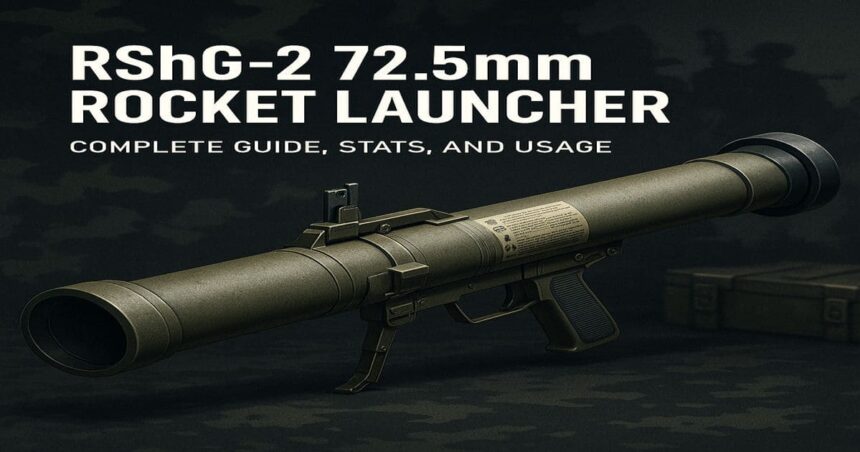The RShG-2 72.5mm rocket launcher is a formidable piece of military hardware that commands attention on the battlefield. Designed for versatility and effectiveness, this lightweight weapon has become a vital tool for modern infantry forces. Whether you’re an enthusiast or just curious about advancements in military technology, understanding the capabilities and history of the RShG-2 will provide valuable insights into its role in contemporary warfare. Join us as we delve into the fascinating world of this innovative rocket launcher, exploring its development, specifications, operational use, and much more!
What is RShG-2 72.5mm rocket launcher?
The RShG-2 72.5mm rocket launcher is a shoulder-fired, portable weapon designed for anti-infantry and light armor roles. Its compact size makes it easily maneuverable in various combat environments.
This rocket launcher utilizes a unique tandem-charge warhead, allowing it to effectively engage both personnel and lightly armored targets. The design emphasizes simplicity and reliability, making it accessible for troops on the ground.
Weighing around 3 kilograms (approximately 6.6 pounds), the RShG-2 can be carried comfortably by individual soldiers without sacrificing mobility. This lightweight nature enhances its tactical flexibility during operations.
The system incorporates advanced guidance features that improve targeting accuracy, increasing its effectiveness against enemy positions. With its combination of firepower and portability, the RShG-2 remains an essential asset in modern military arsenals worldwide.
History and Development of the RShG-2 72.5mm rocket launcher
The RShG-2 72.5mm rocket launcher has a rich history rooted in the Soviet military’s quest for effective infantry support weapons. Developed in the early 2000s, it emerged as a response to evolving battlefield needs.
Designed by the Russian arms manufacturer KBP Instrument Design Bureau, this portable system was intended for use against fortified positions and light armored vehicles. Its design combines simplicity with advanced technology.
Initial prototypes were rigorously tested in various conditions to ensure reliability and effectiveness. The first operational units entered service in the late 2000s, showcasing impressive capabilities that quickly gained favor among troops.
As conflicts evolved, so did tactical requirements. The RShG-2 became an essential asset on urban battlefields where precision and firepower are critical.
Technical Specifications and Features
The RShG-2 72.5mm rocket launcher stands out with its compact design, making it highly portable for ground troops. Weighing in at approximately 4.1 kg, it’s manageable for quick deployment.
Its unique tandem warhead is engineered to defeat reactive armor effectively. The combination of a high-explosive charge and an initial precursory blast enhances penetration capabilities significantly.
With a range of up to 600 meters, the RShG-2 provides versatility across various combat scenarios. Its accurate guidance system ensures reliable targeting in diverse environments.
Additionally, the launcher features a user-friendly sighting mechanism that aids operators in achieving precision strikes swiftly. This ease of use is crucial during intense engagements where time is critical.
Durability remains a key feature; designed to withstand harsh conditions, this weapon can function effectively even in extreme temperatures or adverse weather situations.
Operational Use and Effectiveness
The RShG-2 72.5mm rocket launcher has seen diverse operational use across various conflict zones. Designed primarily for anti-tank and fortified position attacks, it offers versatility on the battlefield.
Its effectiveness is rooted in its unique tandem-charge warhead, which enhances penetration against modern armor. This feature makes it a formidable choice for infantry units facing armored threats.
Moreover, the launcher’s lightweight design allows easy maneuverability in urban combat scenarios. Troops can carry and deploy it quickly without sacrificing firepower.
Users have praised its pinpoint accuracy at close ranges, providing tactical advantages during engagements. The simplicity of operation also means that soldiers require minimal training to become proficient.
Real-world applications demonstrate that the RShG-2 can adapt to varying combat situations while delivering reliable results when deployed effectively.
Comparison with other Rocket Launchers
When evaluating the RShG-2 72.5mm rocket launcher against its counterparts, several factors come into play. Its compact design sets it apart from larger systems like the Javelin or NLAW, making it more maneuverable in tight environments.
The RShG-2 is designed primarily for anti-infantry and light vehicle roles. It can engage targets effectively at shorter ranges compared to heavier launchers that excel at long-range precision strikes.
In terms of warhead capability, the tandem-charge feature gives the RShG-2 an edge over traditional single-warhead designs. This makes it particularly lethal against fortified positions with reactive armor.
However, while other rocket launchers offer advanced guidance systems for improved accuracy, the RShG-2 relies on a simpler approach which may limit its effectiveness in highly dynamic combat situations. Each system has unique strengths tailored to different operational needs.
Advantages and Limitations of the RShG-2 72.5mm rocket launcher
The RShG-2 72.5mm rocket launcher offers several advantages, making it a formidable weapon in modern combat scenarios. Its lightweight design ensures ease of transport and maneuverability on the battlefield. This feature allows infantry units to deploy quickly and efficiently.
One of its standout benefits is the ability to fire a powerful thermobaric warhead. This capability enables the RShG-2 to create devastating effects against both personnel and fortified structures, amplifying its tactical versatility.
However, there are limitations worth noting. The effective range can be seen as restrictive when compared to other systems designed for longer distances. Additionally, while the thermobaric payload is highly destructive, it may not always be suitable for engagements in urban environments where collateral damage is a concern.
These factors contribute to varying opinions among military strategists regarding its overall utility in diverse operational theaters.
Future Developments and Upgrades
The future of the RShG-2 72.5mm rocket launcher looks promising, with several potential upgrades on the horizon. As modern warfare evolves, so too must weaponry adapt to new challenges and technologies.
One area of focus is enhancing guidance systems. Future iterations may incorporate advanced targeting technologies to increase accuracy against moving targets in urban environments.
Another aspect under consideration is improving warhead capabilities. Developers are exploring options for multi-purpose munitions that can effectively engage both armored vehicles and personnel.
Additionally, weight reduction techniques could make the RShG-2 more portable while maintaining its firepower. This would enhance maneuverability for troops in dynamic combat situations.
Moreover, integration with unmanned systems might soon be possible, allowing operators to launch rockets remotely from drones or ground robots. This innovation could revolutionize tactical applications on the battlefield.
Conclusion
The RShG-2 72.5mm rocket launcher stands out as a remarkable piece of military technology. Its historical roots illustrate significant advancements in weaponry, tailored for modern combat scenarios. The technical specifications reveal its robust design and effectiveness against various targets.
Operationally, the RShG-2 has proven its worth in diverse environments, showcasing versatility that is essential on the battlefield. When compared to other rocket launchers, it holds unique advantages while also presenting certain limitations that warrant consideration.
Looking ahead, potential upgrades may enhance its capabilities further, ensuring continued relevance in evolving warfare landscapes. This rocket launcher not only represents a strategic asset but also embodies ongoing innovation within military hardware development. Understanding these aspects allows for informed discussions around its role in contemporary defense strategies and operational planning.











